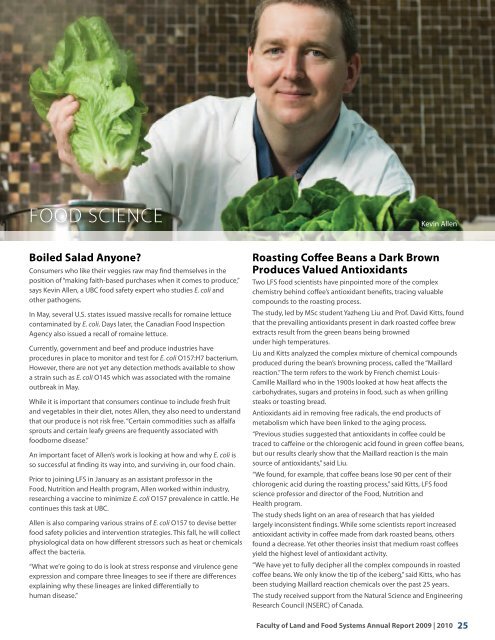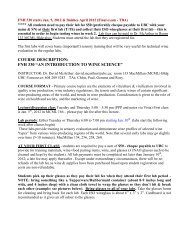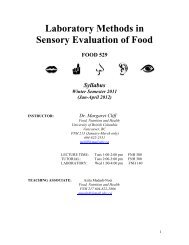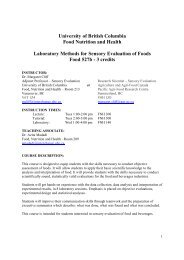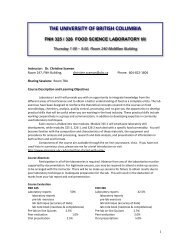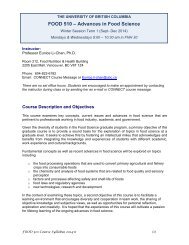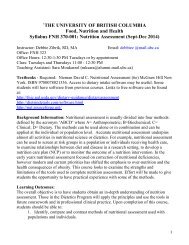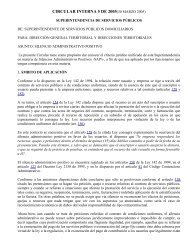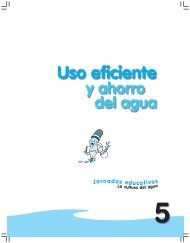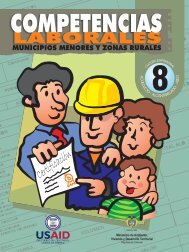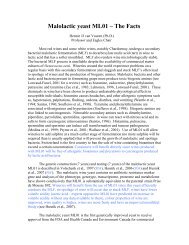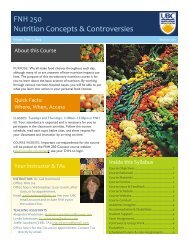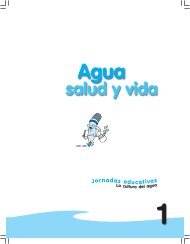download it as a PDF - Faculty of Land and Food Systems ...
download it as a PDF - Faculty of Land and Food Systems ...
download it as a PDF - Faculty of Land and Food Systems ...
- No tags were found...
You also want an ePaper? Increase the reach of your titles
YUMPU automatically turns print PDFs into web optimized ePapers that Google loves.
FOOD SCIENCEKevin AllenBoiled Salad Anyone?Consumers who like their veggies raw may find themselves in thepos<strong>it</strong>ion <strong>of</strong> “making fa<strong>it</strong>h-b<strong>as</strong>ed purch<strong>as</strong>es when <strong>it</strong> comes to produce,”says Kevin Allen, a UBC food safety expert who studies E. coli <strong>and</strong>other pathogens.In May, several U.S. states issued m<strong>as</strong>sive recalls for romaine lettucecontaminated by E. coli. Days later, the Canadian <strong>Food</strong> InspectionAgency also issued a recall <strong>of</strong> romaine lettuce.Currently, government <strong>and</strong> beef <strong>and</strong> produce industries haveprocedures in place to mon<strong>it</strong>or <strong>and</strong> test for E. coli O157:H7 bacterium.However, there are not yet any detection methods available to showa strain such <strong>as</strong> E. coli O145 which w<strong>as</strong> <strong>as</strong>sociated w<strong>it</strong>h the romaineoutbreak in May.While <strong>it</strong> is important that consumers continue to include fresh fru<strong>it</strong><strong>and</strong> vegetables in their diet, notes Allen, they also need to underst<strong>and</strong>that our produce is not risk free. “Certain commod<strong>it</strong>ies such <strong>as</strong> alfalf<strong>as</strong>prouts <strong>and</strong> certain leafy greens are frequently <strong>as</strong>sociated w<strong>it</strong>hfoodborne dise<strong>as</strong>e.”An important facet <strong>of</strong> Allen’s work is looking at how <strong>and</strong> why E. coli isso successful at finding <strong>it</strong>s way into, <strong>and</strong> surviving in, our food chain.Prior to joining LFS in January <strong>as</strong> an <strong>as</strong>sistant pr<strong>of</strong>essor in the<strong>Food</strong>, Nutr<strong>it</strong>ion <strong>and</strong> Health program, Allen worked w<strong>it</strong>hin industry,researching a vaccine to minimize E. coli O157 prevalence in cattle. Hecontinues this t<strong>as</strong>k at UBC.Allen is also comparing various strains <strong>of</strong> E. coli O157 to devise betterfood safety policies <strong>and</strong> intervention strategies. This fall, he will collectphysiological data on how different stressors such <strong>as</strong> heat or chemicalsaffect the bacteria.“What we’re going to do is look at stress response <strong>and</strong> virulence geneexpression <strong>and</strong> compare three lineages to see if there are differencesexplaining why these lineages are linked differentially tohuman dise<strong>as</strong>e.”Ro<strong>as</strong>ting C<strong>of</strong>fee Beans a Dark BrownProduces Valued AntioxidantsTwo LFS food scientists have pinpointed more <strong>of</strong> the complexchemistry behind c<strong>of</strong>fee’s antioxidant benef<strong>it</strong>s, tracing valuablecompounds to the ro<strong>as</strong>ting process.The study, led by MSc student Yazheng Liu <strong>and</strong> Pr<strong>of</strong>. David K<strong>it</strong>ts, foundthat the prevailing antioxidants present in dark ro<strong>as</strong>ted c<strong>of</strong>fee brewextracts result from the green beans being brownedunder high temperatures.Liu <strong>and</strong> K<strong>it</strong>ts analyzed the complex mixture <strong>of</strong> chemical compoundsproduced during the bean’s browning process, called the “Maillardreaction.” The term refers to the work by French chemist Louis-Camille Maillard who in the 1900s looked at how heat affects thecarbohydrates, sugars <strong>and</strong> proteins in food, such <strong>as</strong> when grillingsteaks or to<strong>as</strong>ting bread.Antioxidants aid in removing free radicals, the end products <strong>of</strong>metabolism which have been linked to the aging process.“Previous studies suggested that antioxidants in c<strong>of</strong>fee could betraced to caffeine or the chlorogenic acid found in green c<strong>of</strong>fee beans,but our results clearly show that the Maillard reaction is the mainsource <strong>of</strong> antioxidants,” said Liu.“We found, for example, that c<strong>of</strong>fee beans lose 90 per cent <strong>of</strong> theirchlorogenic acid during the ro<strong>as</strong>ting process,” said K<strong>it</strong>ts, LFS foodscience pr<strong>of</strong>essor <strong>and</strong> director <strong>of</strong> the <strong>Food</strong>, Nutr<strong>it</strong>ion <strong>and</strong>Health program.The study sheds light on an area <strong>of</strong> research that h<strong>as</strong> yieldedlargely inconsistent findings. While some scientists report incre<strong>as</strong>edantioxidant activ<strong>it</strong>y in c<strong>of</strong>fee made from dark ro<strong>as</strong>ted beans, othersfound a decre<strong>as</strong>e. Yet other theories insist that medium ro<strong>as</strong>t c<strong>of</strong>feesyield the highest level <strong>of</strong> antioxidant activ<strong>it</strong>y.“We have yet to fully decipher all the complex compounds in ro<strong>as</strong>tedc<strong>of</strong>fee beans. We only know the tip <strong>of</strong> the iceberg,” said K<strong>it</strong>ts, who h<strong>as</strong>been studying Maillard reaction chemicals over the p<strong>as</strong>t 25 years.The study received support from the Natural Science <strong>and</strong> EngineeringResearch Council (NSERC) <strong>of</strong> Canada.<strong>Faculty</strong> <strong>of</strong> <strong>L<strong>and</strong></strong> <strong>and</strong> <strong>Food</strong> <strong>Systems</strong> Annual Report 2009 | 2010 25


